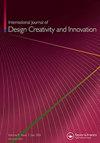以生物为灵感的设计作为产生创意和循环产品概念的解决方案
IF 2.5
Q4 ENGINEERING, MANUFACTURING
International Journal of Design Creativity and Innovation
Pub Date : 2022-10-15
DOI:10.1080/21650349.2022.2128886
引用次数: 0
摘要
消费者越来越关注环境和可持续发展,同时他们对那些“让他们高兴”并超出他们期望的更具创意的产品保持着兴趣。因此,设计师必须满足循环经济(CE)的要求,但也提供创造性的解决方案。本研究描述了一个实验,一组设计师被要求使用两种不同的方法:随机刺激和仿生学来解决设计问题。结果有助于回答这样一个问题,即关注需求(在这种情况下是生物需求)的方法对于获得创造性解决方案是否与面向创造性想法(特别是随机刺激)的方法一样有效。本文还研究了仿生学刺激是否能比随机刺激更大程度地促进循环,以补偿相对于随机方法可能失去的创造力。结果表明,仿生学刺激促进了概念的循环性,但不降低其创造性。本文章由计算机程序翻译,如有差异,请以英文原文为准。
Bio-inspired design as a solution to generate creative and circular product concepts
ABSTRACT Consumers are showing a growing concern for the environment and sustainability, while they keep their interest in more creative products that ‘delight’ them and exceed their expectations. Consequently, designers must meet the circular economy (CE) requirements, but also provide creative solutions. The present research describes an experiment in which a group of designers were asked to solve design problems using two different methods: random stimuli and biomimicry. The results help to answer the question regarding whether methods focused on requirements (biological requirements in this case) are as effective for obtaining creative solutions as methods oriented toward creative ideas (specifically random stimuli). The paper also examines whether biomimicry stimuli promote circularity to a sufficiently greater extent than a random stimulus to compensate for the possible loss of creativity with respect to the random method. The results show that biomimicry stimuli promote circularity in the concepts without diminishing their creativity.
求助全文
通过发布文献求助,成功后即可免费获取论文全文。
去求助
来源期刊

International Journal of Design Creativity and Innovation
ENGINEERING, MANUFACTURING-
CiteScore
3.80
自引率
27.80%
发文量
15
期刊介绍:
The International Journal of Design Creativity and Innovation is an international publication that provides a forum for discussing the nature and potential of creativity and innovation in design from both theoretical and practical perspectives. Design creativity and innovation is truly an interdisciplinary academic research field that will interest and stimulate researchers of engineering design, industrial design, architecture, art, and similar areas. The journal aims to not only promote existing research disciplines but also pioneer a new one that lies in the intermediate area between the domains of systems engineering, information technology, computer science, social science, artificial intelligence, cognitive science, psychology, philosophy, linguistics, and related fields. The journal covers, but is not restricted to, the following topics: ·Theories on Design Creativity and Innovation ·Cognition of Design Creativity ·Innovative Process ·Inventive Process ·Analogical Reasoning for Design Creativity and Innovation ·Design Synthesis ·Method and Tools for Design Creativity and Innovation ·Representation of Design Creativity and Innovation ·Education for Design Creativity and Innovation ·Concept Generation and Inspiration.
 求助内容:
求助内容: 应助结果提醒方式:
应助结果提醒方式:


